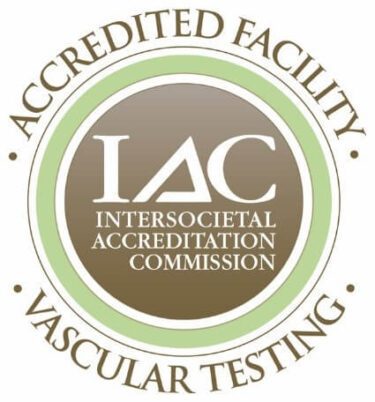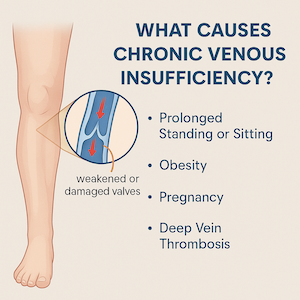Chronic Venous Insufficiency (CVI)
Chronic Venous Insufficiency (CVI), also known as vein disease, occurs when the valves in your leg veins become weakened or damaged — causing blood to pool instead of flow efficiently back to the heart. Over time, this leads to symptoms such as swelling, heaviness, pain, and visible varicose veins.
CVI is one of the most common underlying causes of many vein-related conditions. Find a clinic near you to discuss diagnosis and treatment options.
Common Symptoms of CVI include:
- Hinchazón de las piernas o los tobillos
- Aching, heaviness, or fatigue in the legs
- Skin discoloration or thickening
- Restless legs or cramping at night
- Varicose or spider veins
- Open sores or ulcers (in advanced stages)

Solicitar una consulta

What Causes CVI?
Chronic venous insufficiency develops when vein walls or valves are weakened or damaged. This may result from prolonged standing, obesity, pregnancy, blood clots (DVT), or a family history of vein disease. Aging and hormonal changes can also increase risk.

Cómo se diagnostica
A vascular specialist may perform a physical exam and a duplex ultrasound to evaluate blood flow and check for valve dysfunction or reflux. These noninvasive tests help determine the severity of venous insufficiency.

Chronic Venous Insufficiency Treatments
Fortunately, CVI is highly treatable with modern, minimally invasive procedures.
Los tratamientos comunes incluyen:
- Radiofrequency Ablation (RFA) – seals off damaged veins
- Sclerotherapy – collapses smaller diseased veins
- VenaSeal™ – a medical adhesive used to seal the diseased vein shut
- Varithena – foam-based treatment for varicose veins
- Microphlebectomy – removes large visible veins
- Lifestyle support – compression stockings, leg elevation, exercise
Preguntas frecuentes
While damaged veins cannot be repaired, treatments can reroute blood flow and effectively relieve symptoms long-term.
Varicose veins are often a result of CVI, not the cause.
Yes — untreated CVI can progress to skin breakdown and ulcers.
Adults over 40, women, those with family history, or anyone who stands or sits for long periods.
Artículos relacionados
What Is Chronic Venous Insufficiency (CVI)? What to know about Trump’s CVI diagnosis
Chronic Venous Insufficiency (CVI) recently made national headlines following reports that President Donald Trump has been diagnosed with the condition. While the news has sparked curiosity, it also presents an opportunity to shine a spotlight on a serious — and surprisingly common — health issue.
Éstos son los síntomas de la IVC de los que quizá no haya oído hablar
Poor circulation in the legs can often be a sign of chronic venous insufficiency, a condition where the veins do not function properly to transport blood throughout the lower limbs. Chronic venous insufficiency is a condition that cannot be cured but can be treated to help manage symptoms over one’s lifetime.
